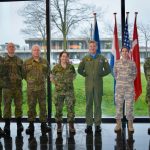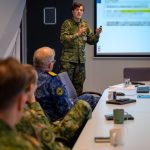- Versie 1.0
- Downloaden 262
- Bestandsgrootte 4.092 MB
- Aantal bestanden 1
- Datum plaatsing 8 juli 2025
- Laatst geüpdatet 8 juli 2025
A Brief History of C2 (Kalloniatis)
The beginning of the history of Command and Control (C2), according to the archaeological record, is coincident with the first recorded instance of warfare, namely organised human violence, in the Battle of Megiddo in 1457 BC. I describe this history initially through warfare in the land domain, where humans, increasingly aided by technology, have naturally fought conflicts since the emergence of Homo sapiens able to walk on two feet, throw weapons by hand and communicate to their fellows by voice. I expand to describe forays into the maritime domain, where true naval warfare exploiting sea manoeuvre manifests, and therefore unique challenges to adopted approaches to C2 on land had to be developed. The history addresses early forays into Joint Operations, through amphibious landings, the development of organised staff systems, Mission Command, and then the next great technological leap into the air domain. As reflected in other classical works such as by Martin van Creveld, Michael Palmer and Andrew Gordon, the importance of delegation and relaxation of control at the top of command hierarchies is a consistent lesson from history. However, as the demand for joint-ness emerges with the complexity of warfare across domain boundaries, the tension with centralising systems for Joint Command becomes evident through this history. Here I describe the development of the Joint Staff system, through evolutions across what I have elsewhere called the first (Napoleonic), second (Prussian-German), third (British-US) and fourth (US-NATO) generations of headquarters. This culminates in a circumspect overview of the various attempts at innovative concepts since the successes of Gulf War I and the introduction of the internet, namely Network Centric Warfare and its variations up to the current Joint All Domain C2 (JADC2) initiative in the US.
A picture emerges across this span of history. Much has changed as technology has enabled speed, mobility, fire-power, and communication across the domains, these technologies over the centuries have become domain-centric (tanks, ships, aircraft) and this has left the legacy of the military services, and now joint components, as the means for fighting in and therefore across the domains including recently in the Cyber and Space domains. Joint integration is forced, within this domain-technology-service legacy, contemporaneously realised as Joint Components, to be a centralising add-on layer, even for Multi-Domain Operations. A lasting tension between centralisation and decentralisation therefore exists, and is difficult to overcome, but must be adjusted in an agile manner. What is unchanged is the human at the heart of C2, with cognitive capacities that have not changed through biological evolution despite millennia of technological revolution. I conclude with reflections on what I believe is an anthropological reality at the heart of C2, drawing also on some of the history of evolution of social governance, that good C2 must always respect the fundamental reality that human beings are profoundly individual beings who live and flourish in a social whole.





